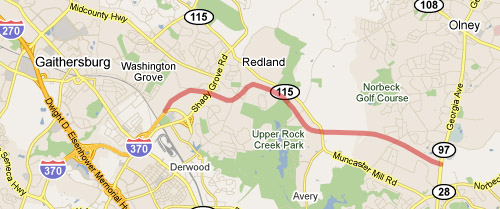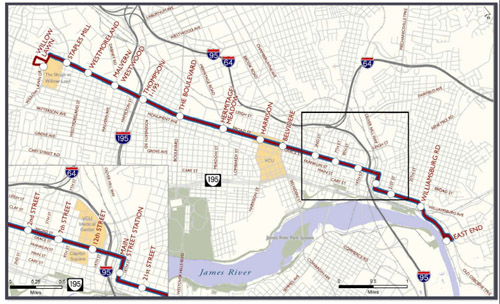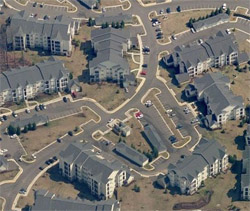Writing about the ICC, as I did yesterday on BeyondDC and today for the Washington Post, is a nostalgia-filled experience for me. It’s a little like coming home.
The ICC was big news in Gaithersburg in the late 1990s, when I was in high school. Newspapers were filled with op-eds debating the merits of the road. I was fascinated, and read them all. I became a big proponent of the highway, because I was bored with suburbia and wanted Gaithersburg to be more like a big city, and in my suburbanite mind big cities had lots of big highways.
Of course I was wrong about what constitutes a big city, and about what relieves traffic congestion, and about a lot of things, but one key epiphany was there: Transportation affects land use. Whoa.
And so it was that I became interested in transportation planning. And so it was that I started writing about it, in letters to the editor of the Gaithersburg Gazette.
So while my position on the ICC has evolved over time, I continue to have a soft spot in my heart for it. The ICC is what started me down the path that has brought me here, to BeyondDC, to the Washington Post, to Greater Greater Washington, and of course to that day job as a professional transportation planner.
I can’t help but be a little nostalgic.
Average Rating: 4.4 out of 5 based on 203 user reviews.
February 8th, 2011 | Permalink
Tags: history, roads/cars, site, transportation, washpostblog
The first phase of the InterCounty Connector will open to traffic on February 22. The ICC will be an interstate-quality highway eventually running from Gaithersburg to Laurel, although this first phase only runs from Gaithersburg to Georgia Avenue. Here’s what opens this month:

The red line is the ICC. The only exit will be at Georgia Avenue.
Until the second phase opens sometime in 2012, the stub-end ICC will be a shuttle between Gaithersburg and Olney, with no intermediate exits except the one for Shady Grove Metro that already exists.
Looking at the map, I’m struck at how much easier the Gaithersburg-Olney trip will become for drivers. Although they’re close geographically, the I-270 and Georgia Avenue corridors are worlds apart psychologically. The ICC will stitch them together.
Thus the ICC’s central conflict: By stitching together the rapidly-growing, jobs-heavy I-270 corridor with the slower-growing, jobs-light eastern suburbs, the ICC will divert growth east causing densification of areas that long ago suburbanized, which in turn will result in less sprawl up I-270. On the other hand, the ICC is a new highway and like all new highways, it will induce more driving. VMT will go up even if sprawl slows down, because the ICC makes suburb-to-suburb travel so much easier.
And then there’s the cost. Maryland took out huge bonds to pay for the ICC, which will have to be repaid with interest, resulting in dramatically less money for future projects. Indeed, the cost of the ICC is a direct reason why Maryland is so reliant on Federal funds that may never come for the Purple Line, Corridor Cities Transitway, and Baltimore Red Line.
So at the end of the day, the ICC is a really expensive way to slow down sprawl a little bit, but to increase traffic while doing so. It’s far from the worst highway that’s ever been built (it’s probably on the more benign end of the scale, in fact), but it’s also far from the most efficient way for Maryland to have spent its limited dollars. Other projects in other places could have slowed down sprawl *and* reduced traffic, at less cost.
More information about the impending Phase 1 opening is available at the ICC website. Thanks to froggie for the heads up.
Average Rating: 5 out of 5 based on 208 user reviews.
February 7th, 2011 | Permalink
Tags: roads/cars, transportation
I’m off to Richmond for the day, for my day job. In honor of the trip, check out the Broad Street Rapid Transit Study, which outlines alternatives for bringing Bus Rapid Transit to Richmond’s busiest transit corridor.

One option for BRT in Richmond.
Average Rating: 4.4 out of 5 based on 182 user reviews.
February 3rd, 2011 | Permalink
Tags: BRT, roads/cars, transportation
|

This does not make sense. |
It is one of the great myths of suburbia that most suburban households live in detached houses, and that therefore suburbia should be arranged exclusively to cater to detached households.
Consider US Census results from Montgomery and Fairfax Counties, the two largest suburban jurisdictions in the region. In both cases single-family detached houses make up about half the total housing stock, with about 20% as townhouses and 30% apartments. Census results also show that in some suburban jurisdictions, such as Gaithersburg, detached houses are a distinct minority, representing less than 21% of the housing stock.
What does this mean? It means that literally millions of people in the DC suburbs alone are currently living at fundamentally urban densities, but aren’t getting any of the benefits of urban living. It means the densities to support mixed-use neighborhoods are already there, but mixed-use neighborhoods aren’t happening because of counter-productive zoning requirements.
This really is ridiculous. Imagine how much less congestion the suburbs would experience if the millions of people living in suburban townhouses and apartments could easily walk to their daily needs. Even if it were just the apartments, and even if it were only half of those, the difference to overall suburban quality of life would be immense.
And that’s without adding one iota of density.
It’s easy to understand why many people think living in a detached house with a private yard is worth the trade-offs. Even if that’s not a choice I personally make, it’s easy enough to see why it attracts other people. Detached houses make sense, from a certain point of view.
But suburban apartments are simply preposterous. If you’re going to be building at that density anyway, then for goodness sake use an urban layout.
Average Rating: 4.8 out of 5 based on 250 user reviews.
February 1st, 2011 | Permalink
Tags: people, urbandesign
















